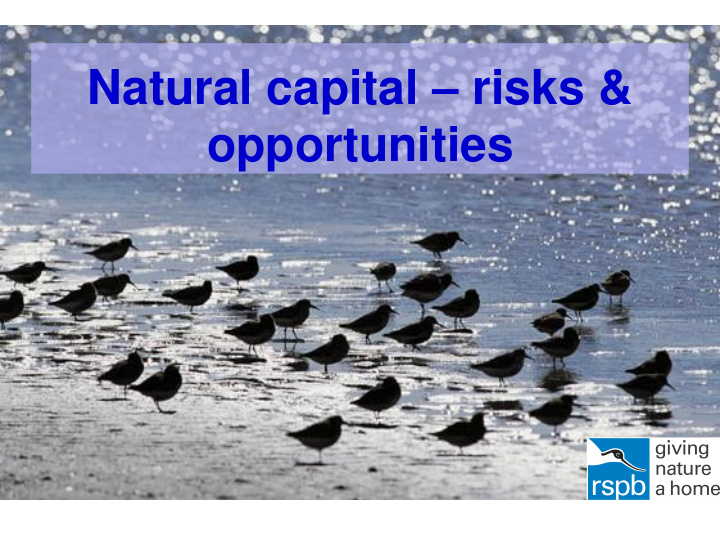



Natural capital – risks & opportunities
Talk outline 1. What is natural capital? 2. Some important points to be aware of 3. A natural capital account of the RSPB’s reserves 4. Examples of land-use changes which typically provide overall benefits to society & increase the value of natural capital
The natural capital approach These figures, ladies and gentlemen, are marmalade. They are finely shredded, boiled to a pulp, heavily sweetened … and still indigestible. In other words they are total gibberish
The natural capital approach We will also set gold standards in protecting and growing natural capital – leading the world in using this approach as a tool in decision-making
So what is Natural Capital? The stock of the world’s living and non -living natural resources, including: • Soils • Water • The atmosphere • Ecological communities • The natural processes that underpin their functioning
Natural capital accounting • Financial accounts usually report the monetary costs & benefits of an activity to the individual/organisation • Natural capital accounts seek to highlight the full costs and benefits of an activity on the state of natural capital
Reproduced from the Natural Capital Protocol, 2016 Provisioning Services e.g. food & fresh water Regulating Services e.g. climate regulation, floodwater attenuation & water purification Cultural Services - non-material benefits such as spiritual and religious benefits, recreation and ecotourism Supporting Services – services which nature provides that are necessary for the production of other ecosystem services e.g. soil formation& pollination
Three important points to be aware of with natural c apital accounting….
1. The value of the ecosystem service benefits that an area provides can depend greatly on location
2. There can be trade-offs. These can include trade-offs between maximising ecosystem service benefits & maintaining/benefitting biodiversity
3 . The full value of biodiversity is under-estimated in natural capital accounts
A Natural Capital account of the RSPB’s reserve network in England https://www.rspb.org.uk/globalassets/do wnloads/documents/positions/economics /accounting-for-nature.pdf
The effects of habitats & their management on the climate – some key points • Determined by estimating the habitat’s greenhouse gas flux • Most habitat management for conservation in itself is bad for the climate • ‘Dry’ semi -natural habitats, undrained peatlands & saline habitats generally produce a net cooling effect on the climate, while eutrophic wetlands can produce a net warming effect • Agriculture produces a net warming effect
Valuing biodiversity in natural capital accounts The approach advocated by the NC Committee is: If land management falls short of achieving a minimum level of maintaining the stock of biodiversity, then the cost of measures within the control of the organisation that are required to remedy this shortfall are reported in the natural capital account as a liability (i.e. as a cost)
The RSPB’s commitment to the biodiversity component of natural capital on its reserves 1) There are no RSPB-managed Sites of Special Scientific Interest for which the RSPB is responsible for the cause of unfavourable condition 2) That breeding populations of priority bird species are at least maintained (and hopefully increased) on its reserve network
A natural capital account of the RSPB’s reserve network in England (values in £m, costs shown in parentheses) Private External Total (RSPB) Discounted sum of 41 1,031 1,072 benefits Discounted sum of (448) (80) (528) maintenance costs Total (407) 951 544
Examples of changes in land-use which typically provide overall benefits to society (i.e. which increase the value of the stock of natural capital)
Conversion of arable to intertidal habitat • Agricultural production • Flood risk management • Commercial fisheries • Climate regulation • Recreational value e.g. MacDonald et al. , 2017 Estuarine, Coastal & Shelf Science RSPB Wallasea Island Wild Coast, Essex
Creation of wetlands on ex-arable or agriculturally improved grassland, which reduce flood risk • Agricultural production • Flood risk management • Climate regulation • Recreational value The Ouse Washes, Cambs/Norfolk e.g. Peh et al. , 2014. Ecosystem Services
Re-wetting drained peatlands • Agricultural production from sheep farming • Climate regulation • (Flood risk management) • (Reduction in water treatment costs) Dove Stone, Derbys e.g. Morison et al . (2010) Forest Research and Lindsey et al . (2010) Unpublished RSPB report
Creating woodlands on ex-arable or improved grasslands near centres of population • Agricultural production • Climate regulation • (Flood risk management) • Recreational use e.g. Natural Capital Committee (2013)
Conclusions • If applied well, adopting the natural capital approach could help deliver big benefits for both nature & people • But there are also big risks for conservation if wildlife is not sufficiently taken into account • Good evidence that recreating various types of semi-natural habitat can provide overall benefits to society & increase the value of natural capital
Thank you! malcolm.ausden@rspb.org.uk
Recommend
More recommend